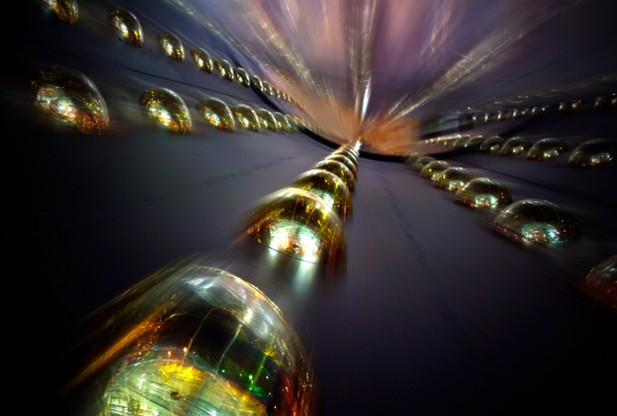An international team of physicists collaborating on a neutrino experiment that began six years ago released their first results on Thursday, and they report that for the first time they have witnessed an elusive process in which one type of these subatomic particles transforms into another.
The findings originate from the Daya Bay Reactor Neutrino Experiment, the first equal collaboration between scientists from the US and China which began in 2006 and has since gained financial, technical and intellectual support from more than 40 different institutions worldwide, according to the US Department of Energy’s Lawrence Berkley National Laboratory (Berkley Lab) at the University of California.
There are three types of “lepton flavors” of neutrinos, officials from the Berkley Lab said in a March 8 press release — electron, muon, and tau. Each of them can transform from one type to another through a process known as mixing angles. There are three of these mixing angles, but prior to now, only two of them had ever been measured and recorded, according to the California Institute of Technology (Caltech).
However, on Thursday, the Daya Bay Reactor team announced that — after watching tens of thousands of interactions with electron antineutrinos captured by six 20-ton neutrino detectors — they had indeed secured an accurate measurement of the third mixing angle, dubbed θ13 or “theta one three”. Theta one three, according to the Berkeley Lab, shows how an electron neutrino can oscillate or transform into one of the other two flavors.
The researchers began observing the transformations on December 24, 2011, hoping to catch a glimpse of the hard-to-detect interaction between the basic types of neutrinos and their corresponding antineutrinos. Their work lasted until February 17 of this year, when they were able to precisely measure the final mixing angle.
According to the Department of Energy, the Daya Bay researchers “first results indicate that sin2 2 θ13 is equal to 0.092 plus or minus 0.017.” A paper detailing their findings has been submitted to the journal Physical Review Letters, officials from Caltech, one of the organizations involved in the project, said.
“This is a new type of neutrino oscillation, and it is surprisingly large,” Yifang Wang of China’s Institute of High Energy Physics (IHEP), the co-spokesperson and Chinese project manager of the Daya Bay experiment, said in a statement. “Our precise measurement will complete the understanding of the neutrino oscillation and pave the way for the future understanding of matter-antimatter asymmetry in the universe.”
Wenlong Zhan, vice president of the Chinese Academy of Sciences and president of the Chinese Physical Society, called the feat “remarkable” and added that they “never imagined” that the project would produce results so quickly. Likewise, Steve Kettel, the chief American scientist involved in the project and a member of the Brookhaven National Laboratory, said that the discovery was “exciting because we have finally observed all three mixing angles, and now the way is cleared to explore the remaining parameters of neutrino oscillation.”
According to Caltech and the Berkeley Lab, the Daya Bay project is attempting to solve attempting to solve some of the universe’s biggest mysteries, including attempting to determine why it seems like neutrinos disappear while they travel, as well as why the universe happens to contain far more matter than antimatter, which allows stars, planets, and even lifeforms to exist.
—

Image Caption: Each antineutrino detector at Daya Bay is lined with photomultiplier tubes to catch the faint trace of antineutrino reactions in the scintillator fluids that fill the detectors. (Photo Roy Kaltschmidt, Lawrence Berkeley National Laboratory)
(原文链接:http://www.redorbit.com/news/science/1112490389/daya-bay-scientists-observe-previously-unseen-neutrino-transformation/) |

